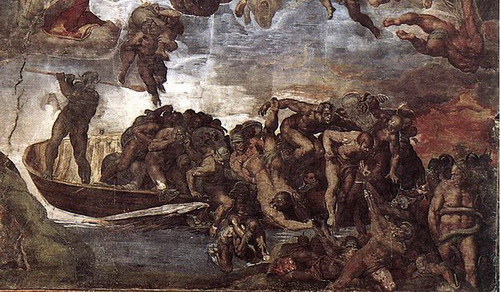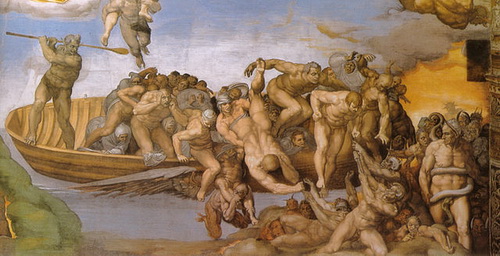The Last Judgement Restoration
How can an act of cleaning be more important than any act of creation? Because the restoration has done more than freshen up or brighten Michelangelo. It has opened the way for a complete new understanding of him, for the banishment of the dark myth of his terribilita his essential pessimism, his angry faith in eternal misery and suffering.
In its previous incarnation the painting was so black that it really was difficult to see what was happening in it, particularly in the bottom half. The vague impression was of a huge expanse of blackish hell, above which hung a gloomy, stormy sky. There were naked bodies everywhere, saints jumbled up with sinners in dark pit-fulls, all bathed in flickering, doomy shadows. An unusually beardless, unusually troubled Christ, loomed above them. He was supposed to be making His decision. But, like everybody else in this maddening crowd, He Himself appeared already to have been found guilty. Hell seemed to creep up the wall in the old Last Judgment until it had conquered most of heaven. The old Last Judgment sealed the myth of Michelangelo's pessimism. The effect of the cleaning has been to challenge this myth comprehensively, on every level. Heaven has been expanded and the boundaries of hell pushed back. It now occupies a narrow band at the bottom of the composition, and quickly gives way to a huge expanse of sky in which most of the action is set, above our heads, defying gravity, floating, unfixed. What had previously seemed a damning image that had already made up its mind about our collective guilt is now an image of far greater uncertainty and therefore more hope. One change the restorers were not able to effect was the removal of the various loincloths and miraculous fragments of flying robe that had been added to the composition to cover up the genitals of the pictured saints and sinners. From not long after Michelangelo completed the image until well into the 18th century, a steady stream of ''improvers'' was employed by various Popes to force these nudes into ecclesiastical line by hacking out their genitals and obscuring them. Overall 38 nudes were painted over in the centuries after Michelangelo finished painting the world's most famous chapel in 1541. The Bible is, of course, very specific about the fact that come Judgment Day we will all stand before the Redeemer as naked as the day we were born. Michelangelo read that, knew that, and painted it. | |
|
|
CONTACT: Address: 00120 Città del Vaticano, Vatican City
|

